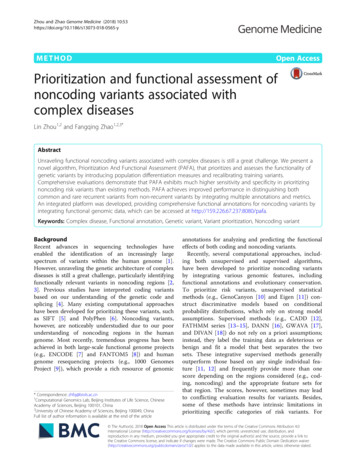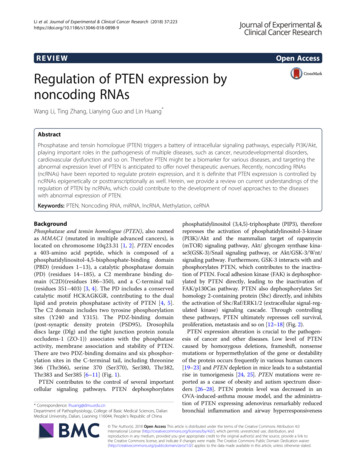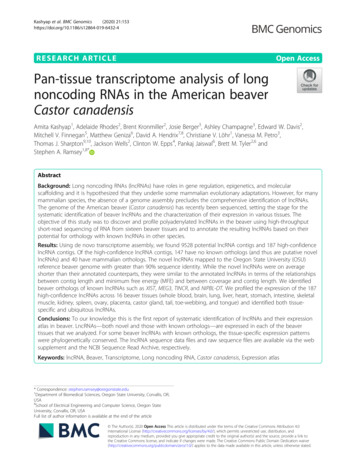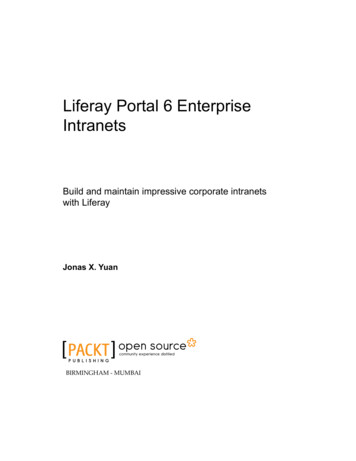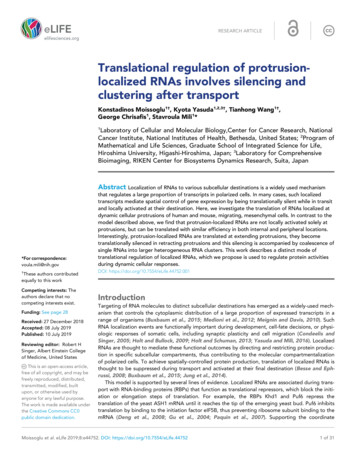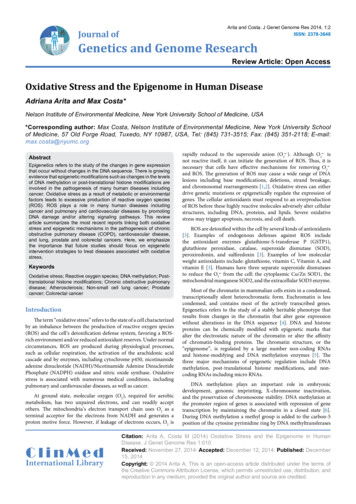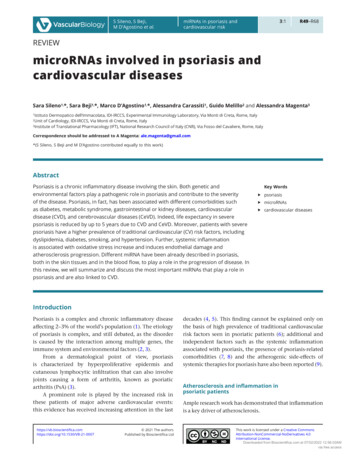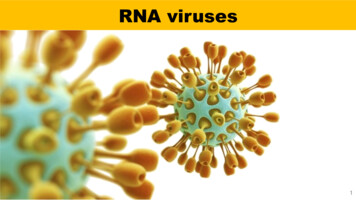
Transcription
Sun et al. Reproductive Biology and 783-4(2021) 19:100REVIEWOpen AccessRoles of noncoding RNAs in preeclampsiaNingxia Sun1,2†, Shiting Qin1,3†, Lu Zhang1,4* and Shiguo Liu1,4*AbstractPreeclampsia (PE) is an idiopathic disease that occurs during pregnancy. It comprises multiple organ and systemdamage, and can seriously threaten the safety of the mother and infant throughout the perinatal period. As thepathogenesis of PE is unclear, there are few specific remedies. Currently, the only way to eliminate the clinicalsymptoms is to terminate the pregnancy. Although noncoding RNA (ncRNA) was once thought to be the “junk” ofgene transcription, it is now known to be widely involved in pathological and physiological processes, includingpregnancy-related disorders. Moreover, there is growing evidence that the unbalanced expression of specific ncRNAis involved in the pathogenesis of PE. In the present review, we summarize the expression patterns of ncRNAs, i.e.,microRNAs (miRNAs), long noncoding RNAs (lncRNAs), and circular RNAs (circRNAs), and the functional mechanismsby which they affect the development of PE, and examine the clinical significance of ncRNAs as biomarkers for thediagnosis of PE. We also discuss the contributions made by genetic polymorphisms and epigenetic ncRNAregulation to PE. In the present review, we wish to explore and reinforce the clinical value of ncRNAs asnoninvasive biomarkers of PE.Keywords: microRNA, lncRNA, circRNA, Biomarker, PreeclampsiaIntroductionPreeclampsia (PE) is a pregnancy-related disorder that isassociated with the unprecedented onset of hypertension(systolic blood pressure 140 mmHg, diastolic bloodpressure 90 mmHg). It occurs after the 20th week ofgestation, and frequently near term. It is estimated thatPE occurs in 3–8% of pregnant women globally [1]. Although PE is usually identified by new episodes of hypertension and proteinuria after 20 weeks of gestation,pregnant women without proteinuria may be diagnosedwith the disorder if they present with one of the following: thrombocytopenia (a platelet count of less than 100,000 per μL); impaired liver function, such as an abnormal rise in the blood concentration of transaminase (totwice the normal concentration), or renal insufficiency(a serum creatinine concentration greater than 1.1 mg/dL, or in the absence of other kidney disease, doubling* Correspondence: 0130aici@163.com; sarah9262020@163.com†Ningxia Sun and Shiting Qin contributed equally to this work.1Department of Medical Genetic, The Affiliated Hospital of QingdaoUniversity, 16 Jiangsu Road, Qingdao 266003, ChinaFull list of author information is available at the end of the articleof the serum creatinine concentration); pulmonaryedema; and the unprecedented onset of headaches thatare unresponsive to medication and cannot beaccounted for by an alternative diagnoses or visualsymptoms [1]. Currently, a strategy for the timely detection and diagnosis of PE is urgently needed. This wouldavoid emergencies or existing complications with targetorgans. There are several related theories about thecauses of PE, including chronic uterine or placental ischemia, immune disorders, genetic imprinting [2],trophoblast apoptosis and necrosis [3], and excessivetrophoblast tolerance to inflammatory reactions [4].Moreover, previous observations have indicated that animbalance of angiogenesis factors may also play an important role in the pathogenesis of PE [5]. All thesepathogenesis processes may be affected by genetic, epigenetic, environmental, and physiological factors, andthere is growing evidence that epigenetics play a role inPE [6]. With regard to epigenetics, modifications to bothDNA and histones are intermediately involved in theregulation of gene activity. Furthermore, the regulation The Author(s). 2021 Open Access This article is licensed under a Creative Commons Attribution 4.0 International License,which permits use, sharing, adaptation, distribution and reproduction in any medium or format, as long as you giveappropriate credit to the original author(s) and the source, provide a link to the Creative Commons licence, and indicate ifchanges were made. The images or other third party material in this article are included in the article's Creative Commonslicence, unless indicated otherwise in a credit line to the material. If material is not included in the article's Creative Commonslicence and your intended use is not permitted by statutory regulation or exceeds the permitted use, you will need to obtainpermission directly from the copyright holder. To view a copy of this licence, visit http://creativecommons.org/licenses/by/4.0/.The Creative Commons Public Domain Dedication waiver ) applies to thedata made available in this article, unless otherwise stated in a credit line to the data.
Sun et al. Reproductive Biology and Endocrinology(2021) 19:100of functional noncoding RNAs (ncRNAs) can alter geneactivity, which modulates gene expression and transcription, chromatin structure, epigenetic memory, selectiveRNA splicing, and protein translation [7].ncRNA is a type of functional RNA molecule that isnot usually translated into protein. It accounts for 98%of the human genome, and includes housekeepingncRNA (transfer RNA (tRNA), ribosomal RNA (rRNA),and small nuclear RNA (snRNA)) and regulatory ncRNA(small interfering RNA (siRNA), microRNA (miRNA),piwi-interacting RNA (piRNA), long noncoding RNA(lncRNA), and circular RNA (circRNA)) [8]. The regulatory ncRNAs can be divided into three types—lncRNA( 200 nucleotides (nt)), miRNA ( 200 nt), and circRNA(circular structure)—which can regulate cell processesthrough direct interaction with each other [9]. For example, miRNAs can regulate gene expression by targeting mRNA [10] or by adjusting its stability by targetingcircRNAs and lncRNAs [11–13]. Alternatively, circRNAsand lncRNAs can serve as “sponges” to adjust the availability of miRNAs [14, 15]. ncRNAs can also adjust thephysiological function of cells by interacting with DNAor proteins [9, 16] The aberrant expression of ncRNAsor their abnormal interactions can lead to the development of various diseases, including PE and cardiovascular disease. There is increasing evidence that miRNAs,lncRNAs, and circRNAs are widely involved in thepathogenesis of PE. In the present review, we summarizethe role of these transcripts in the pathogenesis of PE,and highlight the possible use of ncRNA as a noninvasive tool for diagnosing the condition.miRNAs and preeclampsiamiRNAs are the best studied of the ncRNAs. They aresmall single-stranded structures of approximately 22–25nucleotides that can act as regulators at the posttranscriptional level. When miRNA molecule binds tothe 3′-untranslated region of mRNA molecule, it induces the degradation of the mRNA or prevents itstranslation. It is estimated that miRNAs are able to regulate the translation of more than 60% of the proteincoding genes involved in many physiological processes,such as proliferation, differentiation, apoptosis, and development [17]. Numerous studies have revealed abnormal miRNA expression in the placentas or peripheralblood of patients with PE. Aberrant miRNAs can targetdownstream genes and reduce the migration and invasion of trophoblasts, or increase cell apoptosis, ultimately resulting in PE.Expression pattern of miRNAs in patients with PETo date, approximately 70 miRNAs have been reportedto be differentially expressed in PE tissues. Table 1 summarizes the differentially expressed miRNAs involved inPage 2 of 20the pathogenesis of PE. For the first time, Pineles et al.reported seven differentially expressed miRNAs in theplacentas of patients with PE who gave birth to eithernormal babies or babies that were small for their gestational age. Among these miRNAs, only the levels ofmiR-182 and miR-210 increased significantly relative tothe corresponding levels experienced during normalpregnancy [118]. This finding presented new targets forthe pathophysiology of PE. In view of the role of miR210 in PE, related studies with larger sample sizes further confirmed that the placental expression of miR-210in patients with PE did indeed increase significantlycompared to the corresponding levels experienced during normal pregnancy [18–20]. miR-210 can inhibit theproliferation, invasion, and angiogenesis of trophoblastsby acting on the downstream target genes that encodeKCMF1 [20], NOTCH1 [21] and MAPK [18]. Upregulated levels of miR-210 have also been detected in peripheral blood serum [18]. It has also been reported thatthe disturbed expression of miR-182-5p can inhibittrophoblast proliferation, invasion, and migration by acting on the 3′-untranslated region of RND3 [24]. Zhanget al. first reported that miR-155, an inflammationrelated miRNA, is overexpressed in the placentas of PEpatients, and is involved in the pathogenesis of PE because it downregulates CYR61 [25]. miR-155 can bindthe target genes that encode cyclin D1 [16] and eNOS[26] to affect the migration and proliferation of trophoblasts. Differentially expressed miRNAs have been foundin exosomes [50, 64, 103, 112] and Mesenchymal stemcells (MSCs) [28, 51, 71, 76] as well as in placental tissues and peripheral serum or plasma. For example, miR16 upregulation was first confirmed in the placentas ofpatients with PE [29]. Studies have shown that miR-16 isdifferentially expressed in the decidual MSCs of patientswith severe PE and normal patients, and can inhibit theproliferation and migration of decidual-derived MSCs bytargeting cyclin E1 and inducing cell cycle arrest [28].More interestingly, miR-16 overexpression in decidualderived MSCs can also reduce the ability of human umbilical vein endothelial cells to form blood vessels [28].Diagnostic value of miRNAs in PENumerous studies have confirmed that miRNAs are involved in the pathogenesis of PE and are differentiallyexpressed in patients with this disease. Some researchershave assessed the diagnostic value of miRNA with regardto PE by drawing receiver operating characteristic(ROC) curves. For example, Zhang et al. showed that thelevels of miR-942 decreased significantly in the plasmaof patients with PE compared to the correspondinglevels in normal patients, and had 65.4% sensitivity and69.2% specificity with regard to PE diagnosis [81]. Table 2
Sun et al. Reproductive Biology and Endocrinology(2021) 19:100Page 3 of 20Table 1 Dysregulation of miRNAs in PEMiRNA Sample TCH1/PTPN2/ Upregulation of miR-210 decreased NOTCH1/PTPN2/THSD7A/THSD7A/KCMF1/ KCMF1 expression, impaired HTR-8/SVneo proliferation, migraFOXA1tion, invasion, and tube-like formation capabilities, and promoted regulatedRND3the increased miRNA-182-5p expression could inhibit the migratory and invasive ability of trophoblast cells through targeted degrading RND3 protein[24]miR155placenta/placenta-associatedserum exosomesupregulatedCYR61/Cyclin D1 Overexpression of miR-155 in HTR-8/SVneo cells inhibited cellinvasion, proliferation and increased cell number at the G1stage in trophoblast 5 inhibited cell invasion in trophoblast cells, and theeffect was rescued by over expression of eNOS.[26]miR195placentadownregulated ActRIIB/ActRIIAmiR-195 could promote cell invasion via directly targetingActRIIB/ActRIIA in human trophoblast cells[27]miR-16placenta/mesenchymal stemcell (MSC)upregulatedCCNE1 /VEGF-A/ over-expressed miR-16 inhibited the proliferation and migra[28,Notch2tion of decidua-derived mesenchymal stem cells /BeWo and29]JEG-3 cells, and induced cell-cycle arrest by targeting cyclin E1miRNA- placenta/plasma/exosome376cdownregulated ALK5/ALK7/25OH-VDmiR-376c inhibits both ALK5 and ALK7 expression to impairtransforming growth factor-β/Nodal signaling, leading to increases in cell proliferation and invasion[30,31]miR29bdecidua-derived mesenchymalstem cell (dMSC)/placentaupregulatedmiR-29b induced apoptosis and inhibited invasion andangiogenesis of trophoblast cells.[32]miR101placentadownregulated ERp44/BRD4/CXCL6miR-101 could promote apoptosis and inhibite theproliferation and migration of ulated Smad2/ER1/ESRαmiR-18a could promote trophoblast cell invasion and suppress [35–apoptosis of human trophoblast cells37]miR20aplacentaupregulatedFoxa1/VEGFthe upregulated miR-20a in human preeclampsia tissue can in- [23,hibit the proliferative and invasive activities of trophoblast cells p inhibited the invasiveness of humantrophoblast cells,[39]miR125bplacenta/plasmaupregulatedSGPL1/ STAT3/KCNA1 /GPC1/Trop-2upregulated miR-125b can impair endothelial cell function, reduce cell proliferation and invasion and migration[40–43]miR126placentadownregulated VEGF/PIK3R2miR-126 enhanced endothelial progenitor cell (EPC)proliferation, differentiation and migration[44,45]miR196bplasmadownregulated 6 modulated trophoblast cells migration and invasion[47–49]miR494Mesenchymal stem cells(MSC)/serum exosomesupregulatedVEGF/CDK6supernatant from miR-494-overexpressing dMSCs could reduce [50,HTR-8/SVneo migration, impair HUVEC capillary formation and 51]arrest G1/S ation of miR-519d-3p may contribute to the development of PE by inhibiting trophoblast cell migration and invasion via targeting 5p could inhibit transforming from epithelial tomesenchymal and cell 35 inhibited the migratory ability of the trophoblast cells, [53]and the effect was ‘rescued’ by overexpressed expression of miR-34a inhibited cell proliferation, migration and invasion, and induced trophoblast cell apoptosis byinhibiting expression of BCL-2 204 may contribute to the development of preeclampsiaby inhibiting trophoblastic invasion[58]MMP2/MCL1/VEGFA/ ITGB1/HDAC4
Sun et al. Reproductive Biology and Endocrinology(2021) 19:100Page 4 of 20Table 1 Dysregulation of miRNAs in PE (Continued)MiRNA Sample gulatedTGF-β2miR-193b-3p could regulate trophoblasts migration andinvasion through binding onto the 3’UTR target site of verexpression of miR-193b-5p inhibited trophoblast cell proliferation and miR-203 overexpression inhibited the proliferation, migration[61–and invasion ability of HTR-8/SVneo cells, meanwhile which in- 63]creased the endothelial inflammatory responsemiRNA- placental mononuclear cells and downregulated IL24203aexosomes3pmicroRNA-203a-3p was able to suppress the proliferationcapacity of LPS-stimulated mononuclear macrophages, and itexerted anti-inflammatory effects via down-regulating IL24 inTHP-1 R2 / 4miR-141 could inhibit the invasion and vascularization abilities, [66,and promote the apoptosis of HTR-8/SVneo cells67]miR141-5pplacentadownregulated ATF2miR-141-5p up-regulated transcription factor ATF2 to promotephosphatase DUSP1 expression, which reduces p-MAPK1 andERK1/2 expression to promote a induced the apoptosis of HTR-8/SVneo cells bydown-regulating Bax through the mitochondrial apoptosispathway.[69]miR145placentadownregulated PI3K/MUC1miR-145 may serve key roles in the regulation of trophoblastcell proliferation and invasion[70]miR136Mesenchymal stem cells (MSCs)/ upregulatedserum exosomesBCL2/VEGFMiR-136 significantly increase the apoptosis and suppress theproliferation of MSCs, and it could also inhibit the capillaryformation and trophoblast cell invasion.[71]miR520 gserumupregulatedMMP-2Elevated maternal serum level of miR-520 g level in first trimes- [72]ter could suppress the migration and invasion of trophoblast,and might play a role in the defective spiral artery remodeling,miR20bplacentas and peripheral bloodupregulatedMMP-2miR-20b inhibited trophoblastic invasion by targeting MMP2miR23aplacentaupregulatedXIAP/HDAC2miR-23a reduced HTR-8/SVneo cell migration and invasion and [74,increased HTR-8/SVneo cell apoptosis75]miR495peripheral blood exosomes/umbilical cord mesenchymalstem cells (UCMSCs)upregulatedBmi-1The supernatants from miR-495-overexpressed inhibited themigration of MSCs and HTR-8/SVneo, invasion of HTR-8/SVneoand tube formation of HUVEC[76]miR137placentaupregulatedERRaMiRNA-137 significantly reduced the proliferation andmigration of placenta trophoblast 93 reduced migration and invasion of immortalizedtrophoblast cells.[78]miR144placentadownregulated PTENmiR-144 induced significant increase in cell proliferation,migration, invasion, and decrease in cell apoptosis, and alsoaffected the cell cycles[79]miR144-3pplacentadownregulated Cox-2Downregulation of miR-144-3p led to systemic inflammationand endothelial cell injury[80]miR942plasmadownregulated ENGDecreased miR-942 expression decreased the invasive ability of [81]TEV-1 cells, and inhibited the HUVEC angiogenesis assaymiR134placentaupregulatedITGB1MiR-134 suppressed the infiltration of trophoblast cells bytargeting p/Pax3 axis regulates cell viability, migration andinvasion of HTR8/SVneo cells under hypoxia.[83]miR454placentadownregulated EPHB4/ALK7MiR-454 promotes the proliferation and invasion oftrophoblast cells, and inhibit the apoptosis[84,85]Bax[73]
Sun et al. Reproductive Biology and Endocrinology(2021) 19:100Page 5 of 20Table 1 Dysregulation of miRNAs in PE (Continued)MiRNA Sample gulatedIGF-1the over-expression of miR-30a-3p alter the invasive capacityof JEG-3 cells and induce the apoptosis of HTR-8/SVneo sive miR-31-5p elicits endothelial dysfunction,hypertension, and vascular remodeling via post-transcriptionaldown-regulation of -5p inhibited migration, invasion and proliferation aswell as induced apoptosis in HTR-8/SVneo cells.[88]miR299placentaupregulatedHDAC2miR-299 suppressed the invasion and migration of trophoblast [89]cells partly via targeting on of miR-4421 inhibited trophoblast proliferationand significantly blocked cell sive miR-320a expression remarkably suppressed trophoblast invasion and P-2MiR-517-5p could promote proliferative and invasive abilitiesof JAR cells by inhibiting ERK/MMP-2 7c-3p could suppress cell growth and proliferation, andpromote placental hypoxia, immune response and apoptosis.[93]miRlet-7dplacentaupregulated/low expression levels of miR-let-7d plays a central role in suppressing apoptosis in addition to promoting the proliferationand invasion of PE TCs.[94]miR218-5pplacentadownregulated TGF-β2miR-218-5p accelerated spiral artery remodeling in a deciduaplacenta co-culture and promoted trophoblast invasion andenEVT 2BP2miR-181a-5p may trigger antiproliferation and inhibition of cell [96]cycle progression, induce apoptosis, and suppress invasion inHTR-8/SVneo and JAR cellsmiR142-3pplacentaupregulatedTGF-β1miR-142-3p suppressed cell invasion and migration byreactivating the TGF-β1/Smad3 signaling pathway.[97]miR145-5pplacentadownregulated FLT1/Cyr61miR-145-5p promoted trophoblast cell growth and invasion[98,99]miR30bplacentaupregulatedmiR-30b might contribute to PE through inhibiting cellviability, invasion while inducing apoptosis of placentaltrophoblast cells via MAPK pathway by targeting MXRA5.[100]miR454placentadownregulated ALK7/EPHB4miR-454 promotes the proliferation and invasion oftrophoblast cells by inhibiting EPHB4 /ALK7[84,85]miR200aplasmaupregulatedmiR-200a suppressed primary cilia formation and inhibitedtrophoblast invasion.[101,102]miR548c5pplacenta/ serum exosomedownregulated PTPROmiR-548c-5p could inhibit the proliferation and activation of[103]LPS-stimulated macrophages and decrease levels of inflammatory -342-3p was proposed to inhibit the proliferation,migration, invasion and G1/S phase transition of EB1miR-431 inhibited the migration and invasion of ted THBS2miR-221-3p overexpression inhibited apoptosis, increased cell [107]population at S phase, and decreased cell population at G0/G1phase of HTR-8/SVneo cellsmiR152placentaupregulatedVEGFthe increased miR-152 expression can promote the apoptosisof trophoblast cells.[108]miR133serumupregulatedRho/ROCKMiR-133 may affect the apoptosis of trophoblasts in theplacenta ell proliferation and migration were inhibited by miR-384overexpression[110]MXRA5EG-VEGF/TTR
Sun et al. Reproductive Biology and Endocrinology(2021) 19:100Page 6 of 20Table 1 Dysregulation of miRNAs in PE (Continued)MiRNA Sample pregulatedFOXM1MiR-21 may regulate placental cell atedVEGFAmiR-125a-5p might affect HTR8/SVneo cell proliferation andmigration and inhibit regulation of miR-214-3p promoted trophoblast invasion [113]into the decidua, as well as spiral artery remodelingmiR518bplasmaupregulatedEGR1Increased miR-518b inhibited trophoblast migration andangiogenesis[114]miRNA- serum646upregulatedVEGF-AmiR-646 suppressed endothelial progenitor cells (EPCs)multiplication, differentiation and -215-5p inhibited both the migration and invasivepotential of trophoblasts, besides decreasing the G1-S transition in HTR-8/SVneo cells[116]miR483venous blood/ umbilical cordblood / placental tissuedownregulateIGF1miR-483 regulates the expression of PI3K, Akt, and mTOR inendothelial progenitor cells[117]summarizes the results of research into the value ofmiRNAs with regard to the diagnosis of PE.Association between miRNA variants and the risk of PEGiven that genetic factors play important roles in the occurrence of PE, several studies have focused on the relationshipbetween single nucleotide polymorphisms (SNPs) in miRNAs and the risk of PE. It has also been reported that themiR-146a rs2910164 polymorphism may not be associatedwith PE susceptibility, cytokines, or related characteristics inblack women from South Africa, whereas the GC/CC genotype may reduce susceptibility to severe PE [125]. Interestingly, Salimi et al. discovered that a maternal/placental miR146a polymorphism (rs2910164) was associated with PE orrisk of severe PE, after they genotyped it in the blood samplesand placentas from the Asian mainland, using polymerasechain reaction (PCR)–fragment length polymorphism [126].Table 3 summarizes the reported results.Table 2 Diagnostic value of miRNAs in PEMiRNASample typeArea under 84.50%[124]miR-518bplasma0.5534.40%78.70%[124]
Sun et al. Reproductive Biology and Endocrinology(2021) 19:100Page 7 of 20Table 3 Association between polymorphisms with SNPs and risk of PEMiRNASample typeRisk VariantAssociation with PEminor allele frequencyn n(%)Ref.miRNA-155serumrs767649A alleleT allele(39.2)[127]miRNA-146amaternal bloodrs2910164NegativeC allele(38.7)[126, 128]miRNA-27amaternal blood/Placentalrs895819GC CC vs GGT allele(46)[129]miRNA-196a2maternal bloodrs11614913NegativeT allele(38.6)[130]miR-499Placentalrs3746444CT TT vs CCC allele(37.3)[130]miRNA-152maternal bloodrs12940701CC vs TC TTT allele(28.9)[131]miRNA-26amaternal blood/Placentalrs7372209NegativeT allele(16)[132]Demethylation of the miRNA in PEIn addition to the previously reported abnormal expression of miRNA in PE patients, some studies also foundthat the methylation level of some abnormal expressionof miRNA is associated with the risk of PE. Rezaei et al.found that hypomethylation of the miR-34a promoterwas associated with the occurrence and severity of PE,when they applied methylation-specific PCR to investigate samples from 104 pregnant women with PE and119 normotensive pregnant women [133]. Moreover,studies have shown that the abnormal regulation of themiR-let-7 family is related to PE. The methylation statusof miR-let-7a in PE was evaluated by methylationspecific PCR and bisulfite sequencing PCR analyses. Theresults suggested that hypomethylated miR-let-7a promotes PE by downregulating Bcl-xl and YAP1 [134].The miR-510 promoter region in bisulfite-treated PEDNA samples was also found to be unmethylated, compared to the corresponding region in the control samples [135].lncRNAs and PElncRNAs are composed of more than 200 nucleotides.They promote the development of human diseases byparticipating in various biological processes, includinggenomic imprinting, chromatin modification, regulationof transcription and post-transcriptional gene expression, nuclear transport, and other regulatory processes[136]. There is abundant evidence to suggest thatlncRNA expression in the placenta and peripheral blooddiffers between healthy pregnant women and patientswith PE. This indicates that abnormal lncRNA expression is involved in the pathogenesis of PE.Expression pattern of lncRNAs in patients with PETable 4 summarizes the differentially expressed lncRNAsthat participate in the pathogenesis of PE. For example,Liu et al. discovered that the levels of GASAL1 lncRNAwere downregulated in the placental tissues of 30 patients with PE, compared to the corresponding levels in30 normal controls. They further demonstrated thatGASAL1 lncRNA can directly bind to functional RNA-binding protein SRSF1 to promote trophoblastic proliferation and progression from the G1 to the S phasethrough the mTOR and EBP1 signaling pathways. It canalso inhibit trophoblastic apoptosis by downregulatingcleaved caspase-3 and upregulating Bcl-2 [174]. Anotherwell-known lncRNA, that of MEG3, is expressed in avariety of normal tissues, but is absent in many tumorsand tumor cell lines [189]. Yu et al. found that the expression of lncRNA MEG3 in PE placental tissue decreased significantly by 72% compared with that in thenormal controls, and MEG3 interruption induced theexpression of E-cadherin but reduced that of Ncadherin. This confirmed that MEG3 inhibits trophoblastic migration and invasion. They also found thatMEG3 downregulation affects the TGF-β/Smad pathwayby inhibiting Smad7 expression, thereby suppressing epithelial–mesenchymal transition [147]. Wang and Zoualso showed that by regulating the expression ofNOTCH1, MEG3 can promote the apoptosis of trophoblasts, and inhibit their migration and invasion, therebyinducing PE [148].Although there is no report that the methylation levelof lncRNA itself is related to PE, abnormally expressedlncRNAs can regulate the proliferation, invasion, andapoptosis of trophoblasts by regulating the methylationof downstream molecules. Zhao et al. found that whenlncRNA HOTAIR is expressed at high levels, it targetsmiR-106 by binding to EZH2 [139], which in turn inhibits the transcription of the target gene by inducingH3K27 methylation in the promoter region, ultimatelysuppressing the proliferation, migration, and invasion oftrophoblasts [190]. Xu et al. further confirmed thatEZH2 can directly interact with the promoter region ofRND3 by methylating H3K27, the 27th amino acid ofhistone H3, thereby reducing the expression of RND3 inPE. However, the downregulation of lncRNA TUG1 inplacental tissues inhibits the proliferation, invasion, andmigration of trophoblasts and promotes their apoptosisand it also obstructs spiral artery remodeling by reducing the transcriptional regulation of RND3, which ismediated by recruited EZH2 proteins [143]. Li et al. reported, for the first time, that TUG1 acts as a molecular
(2021) 19:100Sun et al. Reproductive Biology and EndocrinologyPage 8 of 20Table 4 Dysregulation of lncRNAs in PELncRNASample typeStatusTargetsFunctionRef.BC030099the whole blood(WB)upregulated//[137]LOC391533 placentaupregulatedsFlt-1This protein plays an important role in angiogenesisand vasculogenesis.[138]LOC284100 placentaupregulated//CEACAMP8 placentaupregulated//HOTAIRupregulatedmiR-106aHigh level of HOTAIR represses the proliferation,migration and invasion of trophoblast cells throughdownregulating miR-106 in an EZH2-dependentmanner.[139]downregulated PUM1/HOTAIRHOTAIR promotes trophoblast invasion by activatingPI3K-AKT signaling pathway.[140]AGAP2-AS1 placentadownregulated JDP2AGAP2-AS1 knockdown could inhibit trophoblastsproliferation, invasion and spiral artery remodeling andpromote cell apoptosis.[141]HOXA11ASplacentadownregulated miR-15b-5p/HOXA-7/Lsd1 andEzh2/RND3Down-regulated HOXA11-AS inhibits trophoblast ce
the target genes that encode cyclin D1 [16] and eNOS [26] to affect the migration and proliferation of tropho-blasts. Differentially expressed miRNAs have been found in exosomes [50, 64, 103, 112] and Mesenchymal stem cells (MSCs) [28, 51, 71, 76] as well as in placental tis-sues and peripheral serum or plasma. For example, miR-
